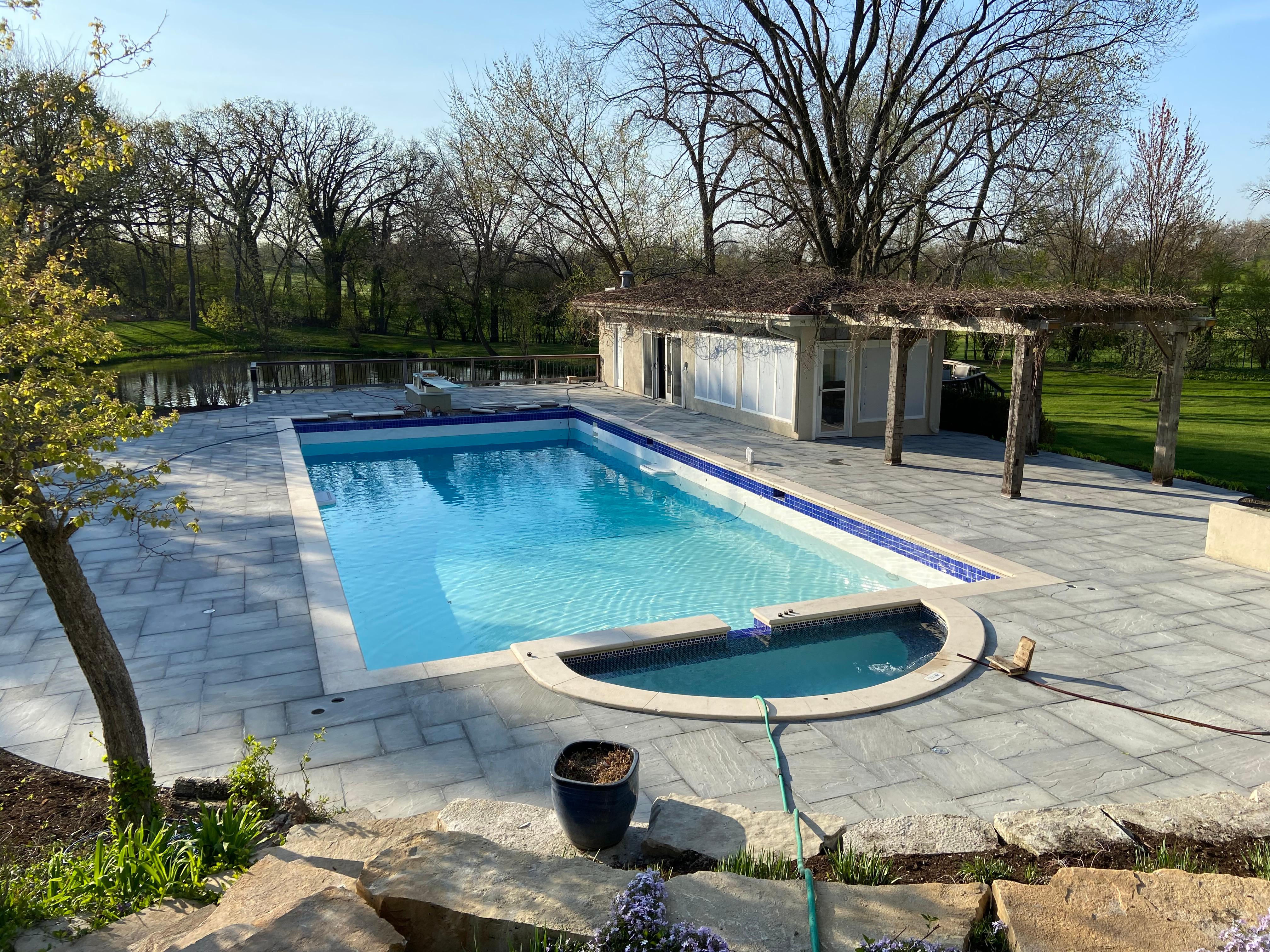How to Secure Your Pool in a Storm

During the summer months here in Illinois, it’s inevitable that we will be met with a few bad storms. And for inground pool owners, those storms can present some real problems when it comes to the safety and hygiene of your pool.
Luckily, there are a few easy ways to prepare your pool for a storm that will help you get it up and running in no time afterwards.
With these tips, you’ll be able to secure your inground pool and avoid major damage from any future summer storms.
Before a Storm
When you know a bad storm is coming, here’s what you need to do to prepare:
Check Your Water Level
The first thing you should check is your inground pool’s water level.
Now, removing the water from your pool may feel like the right thing to do to prevent any overflow, but actually, you should keep your water as is before a storm.
If your water is at a normal level, it’s ready to weather a storm. Your pool more than likely has overflows built-in, which means excess water should safely drain off. Plus, removing any water leaves your pool walls and floor vulnerable to debris damage or scratches.
If you were to remove the water from your pool, there’s a possibility that it could increase the hydrostatic pressure which can lead to your pool floating up from the ground – a worst-case scenario!
So, for all those reasons, it’s best to keep your pool water where it is and move on to the next step.
Remove Your Pool Cover
Again, this might seem counterintuitive. Won’t a pool cover protect your pool from debris or other damage?
Unfortunately, no.
Pool covers can easily be lifted off by the strong winds of a storm, or fall in due to the heavyweight of rain. These covers will also collect debris during a storm, making your pool even more vulnerable to potential damage. Be sure to remove any pool or solar covers before the storm begins.
Turn off Equipment
It’s important to turn off any electrical equipment that powers your pool. If not, this is where your pool could see the most significant amount of damage.
As you’re shutting your pool down for a storm, remember to turn off any:
- Circuit breaker (powering items like your motor, pool pump, chlorinator and lights)
- Propane tanks
- Gas valves
- Additional electronics surrounding or used by the pool
It may be a good idea to invest in a portable generator in case of emergencies as well.
Secure All Outdoor Items
If especially strong winds are headed toward you, it’s important to grab anything outside that’s loose and could damage your pool (or your house!)
This includes:
- Pool toys
- Pool floats
- Chlorine dispensers
- Loose pool covers
- Pool steps
- Lawn chairs, tables or other furniture
- Cleaning supplies (ex. leaf simmers)
Find a safe place for items like this outside, such as a garage or tool shed, or if you’re really worried, bring them inside the house.
Prune Your Surrounding Garden
This might not be possible unless you have a good amount of notice, but if you do, grab your pruning scissors. You could easily save your pool from potential damage by cutting down loose, dying or flimsy branches from surrounding trees or shrubs.
Maintaining Your Pool After a Storm
Once the storm has passed and it’s safe to go outside, it’s time to assess any potential damage that could have occurred and ensure that your pool is healthy enough to use again:
Check Your Equipment
Start by checking on your electrical equipment to make sure it was protected during the storm.
Ensure that your motor, pump and chlorinators are dry, undamaged and working properly, and turn back on anything else you’d previously turned off, like gas or propane tanks.
If any of your electronics did get wet during the storm, have a pool professional inspect the equipment to determine if repairs or replacements will be necessary.
Remove Debris
Once you’re sure your electronics are safe, start removing any debris that entered your pool by using a net, rake or skimmer. The longer you leave that debris in your pool, the more likely it is to stain your pool walls or floors.
You should not use the pool pump for this – larger objects will easily clog your pump.
Test Your Water
Once the large debris has been removed, it’s time to test your pool water with chemicals. This will tell you how to counteract the effects of the rainfall.
Start by using a pH test to check your pool for chlorine, alkalinity and acid demand. Since rainwater is often acidic, it’s normal if your pH differs from the normal range of 7.2-7.6. But, for your chlorine to be most effective, it’s important to get your pH levels within this recommended range.
Once those pH levels are normalized by adding any necessary acid or alkaline substances, it’s time to shock your pool. You can add approximately one gallon of shock for every 5,500 gallons of water. The shock can be poured directly into the water around the perimeter of the pool.
We recommend waiting 24 hours after adding chemicals and testing your pool water levels again with your pH kit. Once the levels are within normal ranges, your pool should be ready for swimming!
When in Doubt, Call a Professional
Storms or no storms, we know how stressful pool maintenance can be.
If you’re struggling with pool care and looking for someone to give you a hand, AAA Pool Service can help. Contact us today to learn more about our weekly maintenance and cleaning offerings for inground pools.